How to Fertilize Your Lawn for Maximum Growth: The Ultimate Guide
- April 10, 2024
- 1 comment
Unlock lush, vibrant growth with our ultimate guide on how to fertilize your lawn. Learn expert tips for the perfect green space. Creating a lush, vibrant lawn goes beyond regular watering and mowing; it requires the right nutrients at the right times. In this ultimate guide, we dive deep into the world of lawn fertilization. You’ll learn about the balance of essential nutrients your grass needs and the best times to apply them.
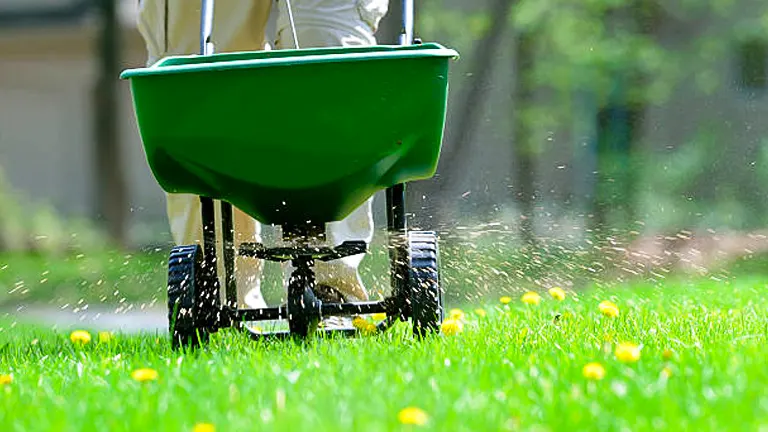
This guide provides all the knowledge necessary to boost your lawn’s health and appearance. Whether you’re a seasoned gardener or a first-time homeowner, our expert tips will help you transform your outdoor space into a perfect green canvas.
Table of Contents
- Understanding Your Lawn
- The Basics of Lawn Fertilization
- Timing and Application
- Step-by-Step Guide to Fertilizing Your Lawn
- Safety and Environmental Considerations
- Advanced Tips for Maximum Growth
- Conclusion
- FAQs
Understanding Your Lawn
Types of Grass
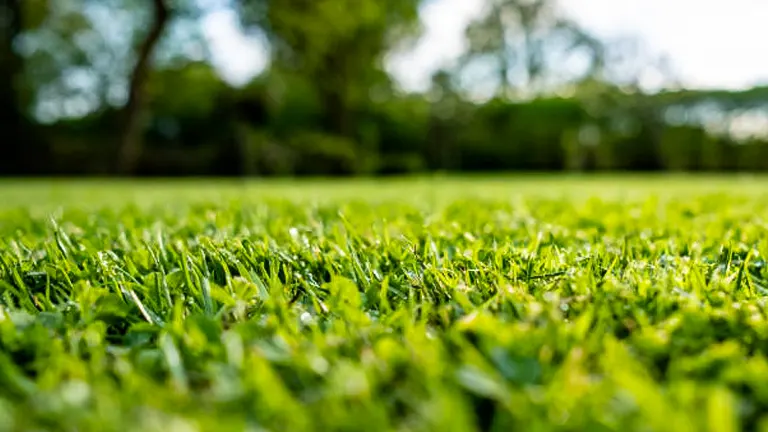
Lawns are composed of various types of grasses, each adapted to specific climates and conditions. The distinction between cool-season and warm-season grasses is fundamental, influenced by their growth patterns and photosynthesis processes.
- Cool-Season Grasses: Species like Kentucky bluegrass (Poa pratensis) and tall fescue (Festuca arundinacea) thrive in temperatures between 60-75°F (15-24°C). These grasses exhibit a C3 pathway of photosynthesis, making them more efficient in cooler temperatures and less tolerant of heat and drought.
- Warm-Season Grasses: Bermuda (Cynodon dactylon) and Zoysia (Zoysia) are examples of grasses that perform best in 80-95°F (27-35°C). They follow the C4 photosynthesis pathway, which is more efficient at higher temperatures and under direct sunlight, contributing to their resilience in hotter climates.
Soil Health
Healthy soil is the bedrock of a vibrant lawn, requiring more than just the right pH and nutrient levels; it needs a balanced ecosystem of microorganisms and organic matter.
- Soil pH and Nutrient Availability: Soil pH, measured on a scale of 1 (acidic) to 14 (alkaline), significantly affects nutrient availability. Most lawn grasses prefer a slightly acidic to neutral pH (6.0 to 7.0). For instance, at a pH below 6.0, nutrients like nitrogen, phosphorus, and potassium become less available, while metals such as aluminum and manganese can reach toxic levels.
- Nutrient Balance and Plant Health: Essential nutrients are categorized into macronutrients (N, P, K) and micronutrients (e.g., iron, magnesium). The optimal ratio for lawn grass generally skews towards higher nitrogen for leaf growth, moderate phosphorus for root development, and adequate potassium for stress tolerance and disease resistance.
Soil Test Interpretation Table
| Nutrient | Optimal Range for Lawns | Effects of Deficiency | Effects of Excess |
|---|---|---|---|
| Nitrogen (N) | 3-5% | Slow growth, yellowing leaves | Excessive growth, increased disease susceptibility |
| Phosphorus (P) | 2-4% | Poor root development, stunted growth | Runoff risk, environmental concerns |
| Potassium (K) | 3-5% | Weak stems, brown spotting on leaves | Rare, but can lead to decreased magnesium uptake |
| pH Level | 6.0-7.0 | Nutrient uptake imbalances, metal toxicity | Nutrient availability decreases |
Advanced Tips for the Enthusiastic Gardener
- Precision Fertilization: Consider employing a soil sensor system for real-time monitoring of soil moisture, pH, and nutrient levels. This technology allows for precise fertilization, tailored to the exact needs of your lawn throughout the season.
- Organic Matter Enhancement: Regularly incorporate organic matter, such as compost or leaf mold, to improve soil structure, water retention, and microbial activity. This not only boosts nutrient availability but also enhances root penetration and overall soil health.
The Basics of Lawn Fertilization
Nutrient Essentials
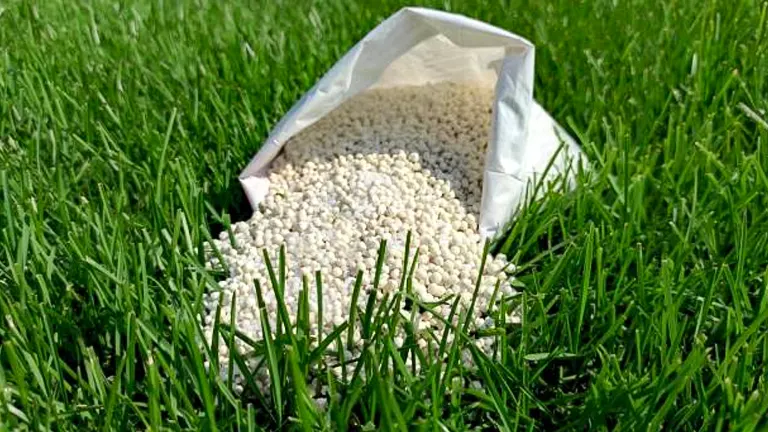
To foster a healthy, vibrant lawn, an understanding of the role and dynamics of essential nutrients is crucial. Here’s a deeper dive into how these nutrients work at a molecular level:
- Nitrogen (N): Nitrogen is pivotal for chlorophyll production, the green pigment responsible for photosynthesis. It aids in rapid foliage growth by facilitating the synthesis of amino acids, the building blocks of proteins. The ideal nitrogen level varies, but a general guideline is 1 to 1.5 pounds of actual nitrogen per 1,000 square feet annually, depending on grass type and health.
- Phosphorus (P): Essential for energy transfer within the plant, phosphorus plays a key role in the formation of DNA, RNA, and ATP (adenosine triphosphate), contributing to root development and flowering. Soil phosphorus is best maintained in a concentration of 20-30 ppm for optimal lawn health.
- Potassium (K): Potassium regulates the opening and closing of stomata, thereby managing water loss and intake. It strengthens plant tissues, making grass more resilient against diseases and environmental stresses. Optimal soil potassium levels are generally between 150-200 ppm.
Selecting the Right Fertilizer
When choosing between synthetic and organic fertilizers, consider their environmental footprint and long-term benefits to your lawn’s ecosystem:
- Synthetic Fertilizers: These are manufactured chemically and can provide nutrients immediately to your lawn. However, they might lead to salt build-up over time and harm beneficial microorganisms in the soil. They’re suitable for quick fixes but require careful application to avoid nutrient leaching.
- Organic Fertilizers: Derived from natural sources, organic fertilizers release nutrients as they break down, offering a slower, more sustained feeding. They improve soil structure and increase microbial activity, leading to healthier soil and plants. Organic options are ideal for those committed to natural lawn care practices.
Reading Fertilizer Labels
Understanding fertilizer labels goes beyond just the N-P-K ratio. Here’s what else to look for:
- Application Instructions: Critical for ensuring that you use the product safely and effectively.
- Micronutrients: Many labels also list micronutrients like iron (Fe) and magnesium (Mg), which are essential for plant health in smaller quantities.
- Release Rate: Indicates how quickly nutrients are available to plants, crucial for timing your applications correctly.
Fertilizer Nutrient Table
| Nutrient | Function | Optimal Soil Level | Visual Indicators of Deficiency |
|---|---|---|---|
| Nitrogen (N) | Promotes leaf growth and green color | 1-1.5 lbs/1,000 sq ft/year | Yellowing, stunted growth |
| Phosphorus (P) | Supports root and flower development | 20-30 ppm | Poor root growth, delayed flowering |
| Potassium (K) | Enhances health, drought, and disease resistance | 150-200 ppm | Browning edges, weak stems |
By adopting a more nuanced approach to lawn fertilization, you’re not only nurturing your lawn but also contributing to a healthier environment. This guide emphasizes the importance of understanding the scientific principles behind lawn care, enabling enthusiasts to make informed decisions that support sustainable and effective practices.
Timing and Application
The Science of Timing
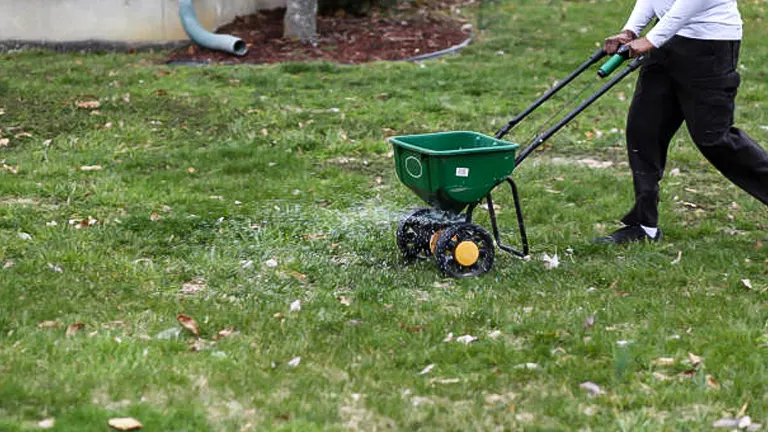
Understanding the physiological growth cycles of your lawn is crucial to optimizing fertilizer application. This involves aligning your fertilization schedule with the grass’s natural growth phases, influenced by temperature, daylight hours, and grass type.
- Growth Cycle Insights: Cool-season grasses enter a vigorous growth phase in cooler temperatures of early spring and fall, utilizing fertilizer more efficiently during these periods. Warm-season grasses peak in growth during the warm months of late spring to summer, aligning with their optimal fertilization window.
Precision in Application
The method of applying fertilizer can significantly affect the outcome, with technology offering new ways to enhance precision and efficiency.
- Innovative Application Methods: Beyond traditional broadcast or drop spreaders, consider using liquid fertilizer applications through hose-end sprayers for more uniform coverage. GPS-guided spreaders, though more commonly used in large-scale agriculture, are finding their way into residential lawn care, allowing for precise application patterns that minimize waste and environmental impact.
Watering Wisdom: The Key to Activation
Watering after fertilization is not just about activating the fertilizer; it’s about ensuring the nutrients are available to the grass roots in a balanced manner that promotes absorption without leaching.
- Soil Moisture Management: Utilizing soil moisture sensors can guide watering post-fertilization, ensuring that the soil is at an optimal moisture level for nutrient uptake. This technology prevents over-watering and under-watering, which can respectively lead to nutrient runoff and poor nutrient absorption.
Fertilization Calendar and Watering Guide
To further refine the application of these insights, here’s a calendar-based guide to fertilization and an accompanying watering strategy to maximize nutrient uptake and lawn health:
| Season | Grass Type | Fertilization Timing | Post-Application Watering |
|---|---|---|---|
| Early Spring | Cool-Season | Begin as grass starts active growth | Light watering for 2-3 days to prevent nutrient runoff |
| Late Spring | Warm-Season | As temperatures consistently warm | Moderate watering, avoiding saturation |
| Fall | Cool-Season | Early Fall to prepare for winter | Maintain soil moisture without causing soggy conditions |
| Summer | Warm-Season | Early Summer to boost growth | Increase watering slightly to facilitate nutrient absorption |
Additional Tips for Success
- Microclimate Considerations: Be aware of your garden’s microclimate. Areas under shade or receiving full sun have differing moisture and nutrient needs.
- Soil Aeration Pre-Fertilization: Aerating your lawn before fertilizing can improve nutrient penetration and root access, especially for compacted soils.
Step-by-Step Guide to Fertilizing Your Lawn
Step 1: Understand Your Lawn’s Specific Needs
- Recognize whether your lawn is composed of cool-season grasses like Kentucky Bluegrass and Fescue or warm-season varieties such as Bermuda and Zoysia. This distinction is crucial as it directly influences the ideal fertilization schedule.
- Utilize a soil test kit available at garden centers or through local extension services to analyze your soil’s nutrient composition and pH level. The results will inform you about the necessary fertilizer type and soil amendments to enhance your lawn’s health.
Step 2: Selecting the Ideal Fertilizer
- Based on your soil test, choose a fertilizer that provides the exact nutrients your lawn requires.
- Decide on using organic fertilizers, which enrich the soil ecosystem over time, or synthetic options for immediate nutrient release. Each has its advantages depending on your lawn care goals.
- The Nitrogen-Phosphorus-Potassium (N-P-K) ratio on the package is crucial. Ensure the ratio suits your soil’s specific needs for balanced nutrition.
Step 3: Perfect Timing
- Apply fertilizer to cool-season grasses during their peak growth in early spring and again in fall. For warm-season grasses, the best times are late spring through summer. Timing your fertilization avoids waste and environmental harm.
Step 4: Lawn Preparation
- Trim your grass to the recommended height to minimize stress and enhance the fertilizer’s effectiveness.
- If the soil is dry, water your lawn one to two days before applying fertilizer to optimize nutrient absorption.
Step 5: Fertilizer Application
- Use either a broadcast or drop spreader for uniform fertilizer distribution. Calibration is key to ensure the correct amount is applied.
- Begin at the lawn’s perimeter, then work your way inward in systematic lines to cover the area evenly without overlap.
- Adhere strictly to the application rate to prevent over-fertilization, which can damage your lawn.
Step 6: Post-application Watering
- Lightly water your lawn to dissolve and push the nutrients into the soil, ensuring they reach the grass roots without burning the foliage.
- Water just enough to moisten the lawn without washing nutrients away, which could harm local waterways.
Step 7: Prioritize Safety and Cleanliness
- Always wear gloves and safety goggles when handling fertilizers to avoid skin and eye irritation.
- Any fertilizer spills on driveways or sidewalks should be promptly swept back onto the lawn to prevent runoff.
Step 8: Observation and Ongoing Care
- Look out for signs of improvement or any adverse reactions in the weeks following fertilization to adjust care practices as needed.
- Keep detailed notes on your fertilization types, schedules, and lawn response. This documentation will serve as a valuable reference for optimizing your lawn care strategy over time.
Safety and Environmental Considerations
Safe Fertilization Practices: Safety should always be a priority when handling and applying fertilizers. Wear protective gear such as gloves and glasses to avoid direct contact with chemicals. Keep children and pets off the lawn until the fertilizer has been properly absorbed or as recommended on the product label.
Environmental Impact: Thoughtful fertilization practices can minimize environmental impact. Over-fertilization and incorrect application methods can lead to nutrient runoff, contaminating local waterways. Using the precise amount of fertilizer and choosing environmentally friendly products when possible can help protect your local ecosystem.
Advanced Tips for Maximum Growth
Soil Amendments
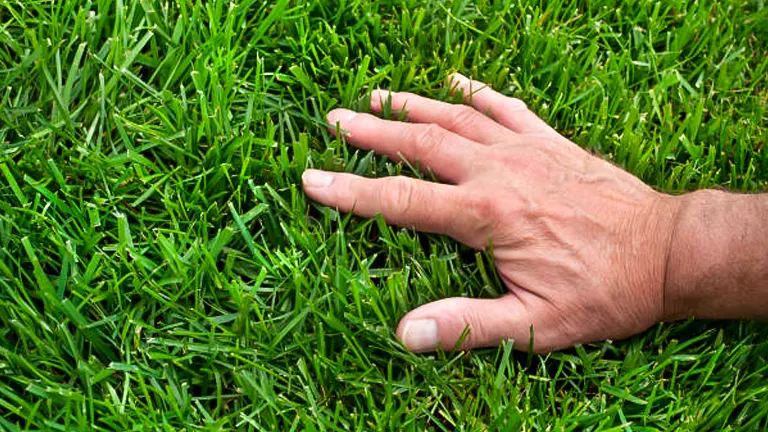
Improving soil health is paramount for a thriving lawn. The introduction of specific amendments should be guided by detailed soil analysis to address its unique composition and deficiencies:
- Organic Matter for Structure Improvement: Incorporating compost or well-rotted manure into clay or sandy soils can dramatically alter their physical properties. In clay soil, it increases porosity, enhancing drainage and aeration. In sandy soils, it boosts water and nutrient retention.
- pH Adjustment for Optimal Nutrient Availability: The availability of essential nutrients is heavily dependent on soil pH, which should ideally be between 6.0 and 7.0 for most lawn grasses. Applying lime to raise the pH or sulfur to lower it must be done in accordance with soil test recommendations to avoid nutrient lock-up or toxicity.
- Microbial Inoculants: Introducing beneficial microbes through biofertilizers can enhance nutrient uptake, promote root growth, and improve soil structure.
Table: Soil Amendment Guide
| Amendment Type | Soil Condition | Benefit | Application Rate* |
|---|---|---|---|
| Organic Matter | Clay/Sandy | Improves structure, aeration, water retention | 3-4 inches incorporated into top 6-8 inches of soil |
| Lime | Acidic | Raises pH, improves nutrient availability | Based on soil test (typically 50-100 lbs per 1,000 sq ft) |
| Sulfur | Alkaline | Lowers pH, corrects alkalinity | Based on soil test (typically 15-20 lbs per 1,000 sq ft) |
| Biofertilizers | Varied | Enhances nutrient uptake, root development | Follow product guidelines |
*Note: Application rates vary based on soil test results and product specifications.
Overcoming Common Challenges
- Bare Spot Rehabilitation: Beyond overseeding, applying a thin layer of topsoil mixed with compost can provide a fertile bed for new seeds, enhancing germination rates and seedling vigor.
- Aeration and Thatch Management: While aeration relieves soil compaction, managing thatch (a layer of dead organic matter on the soil surface) through dethatching or verticutting ensures soil amendments and water penetrate effectively to the root zone.
- Integrated Pest Management (IPM): Implementing IPM involves monitoring for pest activity, establishing action thresholds, and choosing control methods that minimize risks to beneficial organisms, humans, and the environment. This might include biological controls, such as nematodes for grub management, and cultural practices like proper mowing and watering to reduce pest habitats.
Seasonal Lawn Care
- Spring: Test soil and apply amendments as needed. Early spring is ideal for mechanical aeration, especially for compacted soil.
- Summer: Implement deep, infrequent watering to encourage deep root growth. Apply mulch to retain moisture and control soil temperature.
- Fall: Late fall fertilization, known as “winterizing,” provides nutrients for early spring growth. Apply potassium-rich fertilizers to enhance cold tolerance.
- Winter: Minimize traffic on dormant grass. If applicable, use calcium chloride instead of sodium chloride for ice melting to reduce soil salinity issues.
Related Post
- How to Fertilize a Mango Tree Effectively: Tips and Tricks for Healthy Growth
- How to Fertilize Apple Trees: Essential Tips for a Bountiful Harvest
- How to Fertilize Lemon Trees: Secrets for Thriving Citrus
- How to Fertilize Avocado Tree: A Step-by-Step Guide for Lush Growth
Conclusion
By following the steps outlined, from assessing soil health to choosing the right fertilizer, and applying it safely and strategically, you can ensure your lawn not only survives but thrives. Fertilizing your lawn is an ongoing journey, requiring patience, consistency, and a willingness to adapt strategies as you learn more about your specific outdoor space. With the right approach, you can achieve a lush, vibrant lawn that enhances your home’s curb appeal and provides a beautiful, safe place for your family to enjoy.
FAQs
- What’s the best time of day to fertilize my lawn?
The best time of day to fertilize your lawn is in the morning or late afternoon, avoiding the hottest part of the day. This helps reduce the risk of the fertilizer burning the grass blades and ensures that the nutrients are more efficiently absorbed, especially if you water lightly afterward. - Can I fertilize my lawn if it’s expected to rain?
It’s ideal to fertilize just before a light rain, as it can help wash the fertilizer into the soil without causing runoff. However, heavy rain might wash away the nutrients before they can be absorbed. Check the weather forecast and aim for a light rain scenario. - How often should I fertilize my lawn?
The frequency depends on the type of fertilizer and your grass type. Generally, cool-season grasses benefit from fertilization in early spring and fall, while warm-season grasses thrive with fertilization in late spring through summer. Follow the specific product recommendations and consider your soil’s nutrient needs based on a soil test. - Should I mow my lawn before or after fertilizing?
Mow your lawn before fertilizing. This helps the fertilizer reach the soil more easily and ensures it doesn’t cling to the grass blades, which can lead to burning. Ensure the grass is dry when you mow to prevent clumping. - What does the N-P-K ratio on fertilizer packages mean?
The N-P-K ratio represents the percentages of nitrogen (N), phosphorus (P), and potassium (K) in the fertilizer. For example, a 20-5-10 ratio means the fertilizer contains 20% nitrogen, 5% phosphorus, and 10% potassium by weight. This ratio helps you select a fertilizer that matches your lawn’s specific nutrient needs. - How can I tell if I’ve over-fertilized my lawn?
Signs of over-fertilization include yellowing or browning of grass, excessive weed growth, thatch buildup, and even patches of dead grass. If you suspect you’ve over-fertilized, water the area deeply several times to help flush out the excess nutrients. - Is it necessary to water the lawn after applying granular fertilizer?
Yes, it’s necessary to lightly water your lawn after applying granular fertilizer. This helps move the nutrients off the grass blades and into the soil, reducing the risk of burning the grass and aiding in nutrient absorption. - Can I use leftover fertilizer next season?
Yes, you can use leftover fertilizer next season as long as it’s stored properly. Keep it in a cool, dry place, tightly sealed in its original packaging. Make sure to check the expiration date (if any) or any signs of moisture before use, as these can affect the fertilizer’s effectiveness.
This guide is meticulously crafted to provide you with essential tips on optimal lawn fertilization techniques, guiding you towards achieving the fullest growth. Welcome to the path of cultivating a vibrant, verdant lawn that’s the envy of your block!

Emma Hudson
Forestry AuthorEmma's experience in farming shapes her detailed guides on gardening and farming tools, providing practical, actionable advice grounded in real-world experience. Her work targets both newcomers and experienced farmers, aiming to enhance their practices with a mix of traditional wisdom and modern techniques. By making complex agricultural concepts accessible, Emma's guides serve as valuable tools for those navigating the challenges of contemporary farming, offering strategies for sustainable success.













I am a garden service individual and I enjoy your advice
Patrick
April 14, 2024 5:07 am